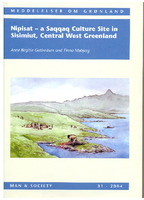Nipisat - a Saqqaq culture site in Sisimiut, central West Greenland (Vol. 331)
| dc.contributor.author | Gotfredsen, Anne Birgitte | |
| dc.contributor.author | Møbjerg, Tinna | |
| dc.date.accessioned | 2010-06-16 00:00:00 | |
| dc.date.accessioned | 2020-04-01T15:29:53Z | |
| dc.date.available | 2020-04-01T15:29:53Z | |
| dc.date.issued | 2004 | |
| dc.identifier | 342365 | |
| dc.identifier | OCN: 1030814727 | en_US |
| dc.identifier | 808382644 | en_US |
| dc.identifier.issn | 0106-1062 | |
| dc.identifier.uri | http://library.oapen.org/handle/20.500.12657/34933 | |
| dc.description.abstract | d on immature individuals caught primarily during their first summer on the breeding grounds. The inhabitants at Nipisat also hunted caribou on the mainland. The age structure and sex distribution of the caribou remains primarily reflect stalking. Selected body parts, especially the fore and hind legs and the heads, were transported to the island for raw material, meat filleting and further processing for marrow extraction and fat rendering. The exploitation of fauna through the entire occupation period was remarkably constant with respect to choice of game animal and the selected age groups. Although eiders were more abundant in phase 1 (36%) than in phase 3 (17%) while gulls increased from 43 to 61% in the same time period. The same trend was found valid for geese, which increased over time while the importance of auks decreased. Harbour porpoise seem to have decreased while walrus increased in relative importance through time. Caribou seem to be of greater importance in phase 3 with 55% compared to 45% in phase 1. The slight shift in preferred resources may be explained by fluctuating abundance and availability of the game species combined with the development of new hunting tools. Based on the new investigations in the Sisimiut District, the gap between Saqqaq and Dorset Culture in Central West Greenland has been diminished. Although resource exploitation at the site seems to have been very stable through all three phases, there are aspects of cultural change bridging the transition from Saqqaq to Dorset Cultures. The introduction of bevelled tools, sturdy harpoon or lance heads and the abandonment of the bow and arrow in phase 3, show cultural affiliation with Dorset technology. This is also true in terms of lithic raw material preference, the introduction of soapstone artefacts and the absence of dwelling structures with a well-defined box-hearth. At the same time it looks like, the central occupation area for the Saqqaq Culture shifted southwards from the Qeqertarsuup Tunua area towards Sisimiut and Nuuk. | |
| dc.language | English | |
| dc.relation.ispartofseries | Monographs on Greenland | Meddelelser om Grønland | |
| dc.subject.classification | thema EDItEUR::N History and Archaeology::NK Archaeology | en_US |
| dc.subject.other | grønland | |
| dc.subject.other | archaeology | |
| dc.subject.other | arkæologi | |
| dc.subject.other | greenland | |
| dc.subject.other | artefacts | |
| dc.subject.other | zooarcheology | |
| dc.subject.other | zooarkæologi | |
| dc.subject.other | english | |
| dc.subject.other | settlements | |
| dc.subject.other | excavation | |
| dc.subject.other | artefakter | |
| dc.subject.other | bopladser | |
| dc.subject.other | udgravning | |
| dc.subject.other | engelsk | |
| dc.title | Nipisat - a Saqqaq culture site in Sisimiut, central West Greenland (Vol. 331) | |
| dc.type | book | |
| oapen.identifier.doi | 10.26530/OAPEN_342365 | |
| oapen.relation.isPublishedBy | bf3aad86-19af-41e9-9504-d166b1caff10 | |
| oapen.relation.isbn | 9788763512640 | |
| oapen.pages | 243 | |
| oapen.identifier.ocn | 1030814727 | |
| oapen.identifier.ocn | 808382644 |

